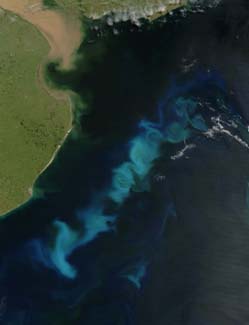
Peter Hurrell* reports on a NERC-sponsored public dialogue, which investigated how members of the public formed their ideas about the controversial idea of mitigating climate change by direct intervention.
Geoscientist 20.12 December 2010/January 2011
Our climate is changing, and man-made emissions of greenhouse gases are probably to blame. But what can we do about it? Maybe, as some scientists suggest, geoengineering can provide the answer. However, deliberately altering our environment is a controversial idea. Earlier this year, before any policy decisions are made, the Natural Environment Research Council (NERC) and Sciencewise-Expert Resource Centre (SERC) sponsored a public dialogue to find out what people really think about geoengineering.
A public dialogue is a good way to find out what people think about an unfamiliar subject, and how they form their opinions. It allows the organisers to introduce a relatively small number of participants to some complex ideas, and a variety of conflicting viewpoints. As new ideas are introduced, participants’ viewpoints may change, and a dialogue can help us understand what causes those changes, and what principles people use when forming their opinions. Geoengineering was an ideal subject for this treatment. It is a complex, potentially contentious new research rea that could directly affect people’s lives and the environment - although few have ever heard of it.
The dialogue consisted of a series of workshops in Birmingham, Cardiff and Cornwall. In each location, we invited 30 people to attend two day-long workshops, held one week apart, to give the participants a chance to think about what they had heard and to discuss it with friends and family.
At the first workshop, participants learned about nine potential geoengineering technologies, from planting trees to injecting sulphate particles into the atmosphere or fertilising the ocean with iron. They had the chance to discuss the technologies with the scientists who also attended the workshops. The second workshop introduced participants to some of the ethical, legal and societal issues that could arise if geoengineering were ever deployed.
We also ran discussion groups for young people in Birmingham, and for people at risk of flooding in Cardiff. Science centres in Birmingham, Cardiff and Oxford held open access events, and we conducted an online survey to give as many people as possible the chance to comment.
So what did we find? None of the participants objected to the idea of geoengineering in principle, but they wanted answers to a number of questions before any geoengineering took place. They wanted scientists to have a better understanding of potential side-effects. “We’ve already wrecked the atmosphere; we don’t want to wreck the ocean too.” said one participant from Birmingham. Many wanted to know whether we could reverse the effects of the geoengineering technologies if required, and whether the benefits of deploying the technologies would outweigh the carbon, financial and environmental costs.
Participants tended to like schemes designed to remove CO
2 from the atmosphere more than ideas designed to reduce global temperatures by reflecting sunlight back into space. This was summarised by one participant; “The solar management options might help cool the planet down but they don’t help solve the problem of taking away the carbon dioxide.”
However, participants also thought that no single solution would be enough to tackle climate change, and that geoengineering should be associated with efforts to reduce carbon emissions. Said one Cardiff participant: “We should do both – mitigate, and use the geoengineering system. People still need to remember to cut CO
2”.
“Naturalness” good
Another important principle for participants was that of ‘naturalness’. Geoengineering ideas that replicate processes already found in nature were preferred. Afforestation and biochar, both seen as ‘natural’, were favoured over technologies seen as interfering in complex natural systems - such as iron ocean fertilisation. Commenting on afforestation through the online survey, one contributor said: “We are balancing the environment rather than unbalancing it with flawed technology.” Cloud whitening was the favourite solar radiation management idea as it mimicked natural cloud formation processes - although it was not generally a popular option.
Participants also recognised the global scale of the problem, and of any potential solutions. “We should not be making choices for developing countries. They should be involved in making the decision” said one participant from Cornwall. Participants felt that they would like more public engagement as scientists learn more about the geoengineering options available, and that any future dialogue should include people (including scientists) from around the world. They also felt that geoengineering decisions should be taken by scientists, as the public do not have enough information to make an informed choice.
Results
Early results from the dialogue workshops have already informed research proposals stemming from a ‘sandpit’ event on geoengineering, organised by the Engineering and Physical Sciences Research Council (EPSRC), with co-funding from NERC. The dialogue also contained several lessons for anyone interested in communicating with the public about climate science, and these are being used by the Living With Environmental Change partnership.
NERC will use the results of the dialogue when considering future strategic priorities. Policy-makers and Non Governmental Organisations (NGOs) were involved throughout the dialogue process to ensure that the results will be useful to others with an interest in geoengineering research or deployment.
We would encourage anyone with an interest in geoengineering to take a look at the dialogue report and think about how the public’s views on geoengineering can inform your work.
* Peter Hurrell is Stakeholder Liaison Officer, KE Policy and Partnerships Team at the Natural Environment Research Council (NERC). E: [email protected]